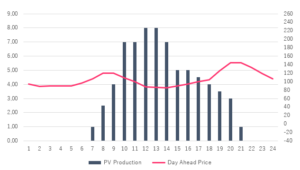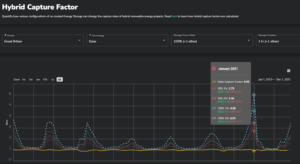
Energy storage solutions are not merely excellent flexibility assets for the grid. They can also improve a solar asset’s revenue through wholesale trading. The eagerly awaited era of co-location is here.
Don’t forget to watch our webinar on-demand ‘Co-located energy storage: how to increase your renewable project value’ hosted by Brian Knowles, Senior Energy Storage at Pexapark, for more first-hand insights.
It has not been very long since energy storage became part of the renewables industry’s everyday vocabulary. It’s been a wild journey, and the niche concept gained momentum impressively quickly. It doesn’t come as a surprise. An anecdotal industry saying goes ‘we were so busy with decarbonisation, that we somehow forgot the grid’.
Therefore, as the electricity mix is rapidly changing, new challenges are arising, but energy storage came to the rescue, fast. And thus begun the avalanche of battery storage facilities as multi problem-solvers.
But let’s take things from the beginning.
What is energy storage? In its intrinsic definition, energy storage is about decoupling energy production and consumption; storing energy to use at a later time. In the electricity sector, grid-scale energy storage became pivotal as predictable, easy to manage power sources such as coal, oil, or natural gas, are being replaced with intermittent renewables. Intermittency makes renewable energy more challenging to control and store. There are multiple energy storage technologies, but in this article we are focusing on one.
What is battery storage? Battery storage, also known as battery energy storage systems (BESS) which is a type of electrical energy storage system (EESS), is the latest technology of energy storage systems suitable to address the new hardships in the electricity sector. The reason behind the popularity of the technology, especially lithium-ion based systems, is its great versatility. BESS can be deployed across the entire value chain of electricity; in generation, transmission, distribution and by end consumers.
Utility-scale battery storage solutions emerged as tools to address multiple issues inherent to the deployment of renewable energy. But this also brought some challenges in defining business models to make the economics work. Because just like any emerging technology, batteries initially came at a high cost.
The two dominant needs arising as more renewables enter the grid are:
Grid flexibility: The rising share of intermittent generation assets poses massive challenges for grid management. The need to balance supply and demand on a real time basis requires capacity that can be dispatched faster than conventional generation assets. A prime example of how grid operators manage this is Frequency Response Services. Such services are required to maintain the grid’s frequency –determined by the balance between electricity generation and demand – at the golden spot of 50Hz (+-1%) across Europe and GB.
Renewable’s intermittency: The intermittent nature of renewable energy is no longer seen as an unsolvable flaw. On the contrary, the momentum is around ‘fixing’ intermittency at the source of the problem, making renewables’ output more ‘grid-friendly’. You may not be able to store the fuel, as in wind and sun, but you are able to soak up excess power and inject it at times of low supply. In short, the addition of storage remedies the problem of intermittency.
Addressing the need for flexibility
Contracted revenue streams for short-duration standalone battery storage
As batteries became one of the missing pieces to complete the energy transition puzzle, business opportunities started arising in every part of the electricity value chain. Grid operators and regulators are creating a plethora of routes to market in the form of grid services for batteries to support the technology’s deployment and eventually take advantage of its competitive edge: fast flexibility.
And thus, the momentum around standalone large-scale battery storage, as in BESS systems not paired with a generation asset, is flourishing. Great Britain is the biggest standalone battery storage market across Europe, by far. From the breakthrough in 2017 following the country’s innovative Enhanced Frequency Response (EFR) auction which remunerated storage operators for responding fast to grid needs, through to the golden age of the Capacity Market (CM) and the much sought-after 15-year contracts, to the latest craze of the Dynamic Containment (DC) auctions.
Germany’s Primary Control Reserve (PCR) market, which is a form of frequency regulation, attracted a fair amount of investment in battery storage facilities, making it the second-largest battery storage market in Europe. A series of balancing services provide similar opportunities to markets such as the Netherlands and the Nordics.
The emergence of ‘value stacking’ and the imminence of saturation
The majority of the business models for such standalone projects is built around value stacking, also known as revenue stacking, with assets aiming to tap as many revenue streams through grid services as possible. The idea of revenue stacking lies behind the fact that a single revenue stream cannot underpin the entire business case of a storage facility.
Therefore, multiple revenue streams though grid services are being exploited to make the most of an asset’s revenue potential. It is important to note that nowadays such grid services usually provide short-term contracts (weekly, monthly). Long-term contracting is rarely available, except for some Capacity Markets across Europe, such as Great Britain and Belgium.
GB’s Capacity Market was the first one to be established and has attracted most of the attention due to some generous 15-year contracts to a few lucky storage projects. Such contracts provide a welcome income to enhance the financing case of the asset, but additional revenue streams through grid services are actively sought after through active monitoring and strategy.
Modo Energy’s graph below illustrates a breakdown of revenues for GB’s battery storage systems. Dynamic Containment’s (low) domination is apparent after its introduction in September 2020. In November, the region’s grid operator National Grid ESO, announced some market reforms that suggest a drop in procurement requirements. The effect is clear in November’s and December’s revenues, which were partially replaced from monthly FFR contracts.
Source: Modo Energy
Despite the battery storage success story in GB overall, the business case is still underpinned by significant revenue uncertainty that makes debt financing tough. In addition, such regulation-led procurement initiatives do have a certain limit to volumes needed overall. For example, in Dynamic Containment (low), volumes procured are around 600MW- 800MW monthly. With around 10GW of BEES in pipeline, such markets are unlikely to support the energy storage capacity needed.
Saturation in Germany’s PCR market revenues led to a halt in the country’s standalone storage efforts. Still, as will be mentioned below, the interest is now in a different business model.
Managing renewables intermittency
Co-location of long-term energy storage with renewables to manage the output
Batteries can be configured flexibly (BESS come in various sizes and configurations) and can be deployed to virtually any site, making them the most popular form of storage to pair with renewables to manage their intermittency. This business model is different from the one pursued for standalone storage projects. Contrary to the exclusive provisioning of grid services, they also improve the value of the energy generated by a renewables project by injecting stored power into the grid during the most valuable times.
A series of countries have already taken steps in this direction. A prime example is Germany’s ‘innovation auction’ held in October 2020, targeting renewables-plus-storage projects.
The concept of battery storage solar co-location is not new. But it took more time to advance due to technical, regulatory and cost-benefit reasons. At Pexapark, we believe that a significant opportunity for the model lies in the subsidy-free merchant renewables sphere. As the pace of buildout increases cannibalization challenges, and as battery pack prices are falling, the potential benefits of storage co-location are now clearer than ever.
Quick flexibility alone won the sprint, but there’s more than meets the eye to win the marathon.
Cannibalization & Capture Factors
Depending on the time a solar asset will inject electricity to the grid, price for its production is subject to many factors. A common misconception when a renewables producer aims to estimate its revenues from a market, is to look at historic monthly average spot prices. Also known as the system’s baseload price, this value illustrates the realised traded price for firm non-intermittent baseload contracts, typically fossil-fuel based. It is extremely important to understand that baseload prices are defined by the fuel price of the generation technologies, for example natural gas, coal, lignite, or oil. When natural gas prices are up, electricity sold by natural gas-fired plants also goes up.
Due to the renewables’ zero marginal cost (no fuel price because the fuel, as in wind and sun, is ‘free’), when they bid in the day-ahead wholesale markets, they bid at zero. However, the price they will get is what the baseload price (defined by which plants are selling to the grid at that time) is. Therefore, renewables are commonly referred to as ‘price takers’, instead of ‘price setters’.
And this is where the cannibalization effect comes into play. Renewables commonly produce at the same hours, and that’s particularly material for solar assets. Therefore, solar assets in a pricing zone will sell their electricity at the same time. This means that fewer more expensive electricity generation units will be dispatched at that time. Since solar bids are at zero (due to the marginalist approach explained above), the realised prices the solar asset will achieve in real time, would be different from the average daily/monthly baseload prices. Capture factors define what percentage of the baseload price is realised by a renewable asset:
Capture factor= capture price/ baseload price
As more and more renewables with similar generation profiles depress the wholesale market price during hours where they produce, the capture factor will drop successively. In mature markets with increased renewables penetration, cannibalization risk becomes a substantial threat to project economics. As price capture for solar assets falls in these markets, a project’s profitability gets stressed, and financing becomes more difficult.
Profile Shaping: battery storage to the rescue
Energy storage systems are a natural hedge against cannibalization and meaningfully improve a project’s capture price. Shaping the production profile involves time-shifting production when the grid most needs it. The model presents a win-win situation for both grid operators and producers: inherent to electricity sales is the fundamental market principle of supply. When demand is higher, prices also go up.
As illustrated in the graph below, a typical solar generation profile doesn’t always match demand and thus in some markets, solar generation is at risk of missing the most valuable hours of wholesale pricing.
Indicative Summer Solar Case –(10MWac)
For profile shaping, the business model is straightforward. Historical patterns of production and spot prices can be used to determine optimal times for charging and discharging the storage facility.
The model is essentially all about price arbitrage (time-shifting production to valuable hours of the day). In the case study we use, optimal hours for charging would be 12h and 13h, when production is high but prices are low. The asset would save valuable energy for the hours between 20h-22h.
The next graph illustrates an example of a 10MW solar PV co-located with a 10MW/20MWh battery.
Indicative Summer Solar Case (10MWac & 10MW/20MWh Battery)
Pro tip: MW illustrates the battery’s power, and MWh displays the energy or duration. Therefore, a 10MW/20MWh indicates that the battery has a 2h duration (10MW x 2h=20MWh), if it discharges at full power (10MW). However, an operator may choose to use this duration incrementally across different time slots depending on the optimisation strategy.
The below graph shows that the combined solar-plus-storage generation profile appears more streamlined with the wholesale prices movements.
Indicative Summer Solar Case (10MWac & 10MW/20MWh Battery)
The Pexapark Hybrid Capture Factors: offering long-term visibility of the benefits of solar-plus-storage
Pexapark changes the narrative of solar-plus-storage. The energy storage industry flourished on increasing fast responding short-duration lucrative revenue streams behind regulation markets, as analysed above. However, there is a lingering uncertainty shadowing the battery storage market, as such regulation is constantly evolving. Although a flexible grid needs flexible regulation that ensures that services are fit for purpose, investors’ minds do not work in a similar manner. Investment appetite for the co-location model relies heavily on identifying long-term revenue streams to justify development capital, but these have not been available – up until now. So, what does the future of energy storage hold?
Beyond welcome regulated incentives, visibility of the long-term benefit a storage asset can have to a solar asset will help build a more robust business case. Turning a solar asset into a proactive player in wholesale markets, alongside the provisioning of grid services where regulation allows, represents the most reliable and bankable revenue stream for co-location.
Interesting fact: Modo Energy’s revenue distribution chart shown earlier in the article indicates that wholesale trading revenue significantly increased during Q4 2021, as decreased revenues from Dynamic Containment (low) and high energy prices impacted optimisation strategies.
This is why Pexapark has added the Hybrid Capture Factor feature for solar-plus-storage, as part of our signature award-winning PPA price reference and market data platform, PexaQuote.
Our new feature quantifies the benefits that various configurations can have on a solar asset’s performance, based on capture prices achieved. Specifically, the feature allows developers and investors to simulate different scenarios to identify the optimal power ratio and storage duration with respect to a solar asset’s capacity.
Capture rates vary in different markets, driven by the density of renewables in a particular pricing zone. Therefore, there will be different ratios of power and battery duration configurations to optimise capture rates, depending on the asset, the battery and the location. Pexapark’s market data can help you fine tune this arrangement to build the perfect scenario to future proof your asset as the build out of renewables continues.
The below example illustrates an indicative case study for a solar asset in GB. By using historic capture rates and historic baseload prices as reference points, we tested different scenarios to see the improvement that could have been obtained with a battery storage asset (incremented lines).
Despite current market momentum being around short-term duration storage (0.5-1h), our findings illustrate that longer duration and higher storage power capacity result in higher capture prices. However, this doesn’t mean long-duration storage can meet everyone’s business goals. There are cost/benefit parameters, alongside technical feasibility, grid constraints and regulatory elements to take into consideration. This is why we add a plethora of options to test the best configuration for your specific case.
A battery storage facility is a physical call option for future volatility
Among the commodities world, electricity witnesses the wildest volatility percentages. In fact, a few battery storage players have been in favour of the abolishment of mechanisms that distort volatility, such as GB’s Capacity Market.
On average, the price volatility of baseload contracts lies around 20-50%. Since Q4 2021, volatility has reached up to 250%. At the same time, the volatility of hourly prices that matters for storage assets has also surged several-fold over levels seen in the past. At Pexapark, we view storage assets as an effective way to help renewables manage short-term volatility in the power markets, especially as cost of battery storage are decreasing, finally making the gains greater than the costs.
Pexapark’s energy storage solutions comprise data such as the Hybrid Capture Curves, as well as quant-driven advisory. We are able to give you visibility into the profitability of your co-located asset and discuss your needs.
To find out more about how we can help, you’re welcome to reach out at brian.knowles@pexapark.com to arrange a coffee with Brian Knowles, Senior Energy Storage Advisor at Pexapark.







